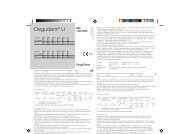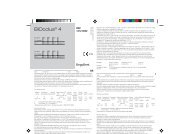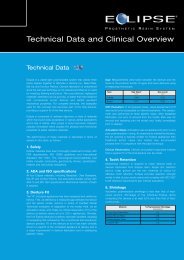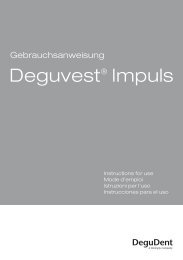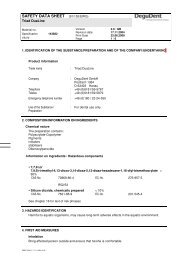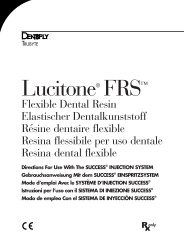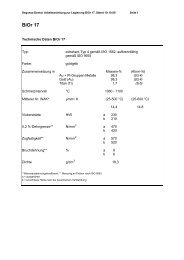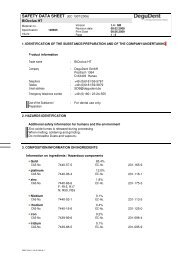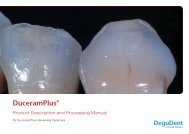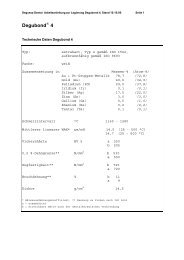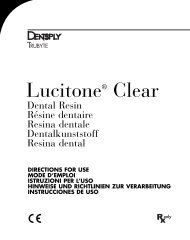Guidelines for veneering non-precious alloys ... - DeguDent
Guidelines for veneering non-precious alloys ... - DeguDent
Guidelines for veneering non-precious alloys ... - DeguDent
Create successful ePaper yourself
Turn your PDF publications into a flip-book with our unique Google optimized e-Paper software.
<strong>Guidelines</strong> <strong>for</strong> <strong>veneering</strong> <strong>non</strong>-<strong>precious</strong><br />
<strong>alloys</strong> consistently with Duceram ® Kiss<br />
Due to the difference in behaviour of <strong>non</strong>-<strong>precious</strong> <strong>alloys</strong> compared with <strong>precious</strong> <strong>alloys</strong> during fi ring, please adhere<br />
strictly to these guidelines to ensure consistent results when working with <strong>non</strong>-<strong>precious</strong> <strong>alloys</strong>:<br />
– Only use new material and ceramic crucibles when casting <strong>non</strong>-<strong>precious</strong> <strong>alloys</strong>. Avoid sharp angles when preparing<br />
the framework. Sandblast the framework with aluminium oxide 250 µm at 3–4 bar.<br />
– Oxide fi ring is not strictly necessary and serves only as a control measure.<br />
– To avoid discolouration, grind or sandblast any exposed parts of the framework (connectors and full pontics) after<br />
every fi ring and then steam or wash clean.<br />
StarLoy soft<br />
Classical <strong>non</strong>-<strong>precious</strong> alloy<br />
such as StarLoy C<br />
Duceram ® Kiss<br />
<strong>non</strong>-<strong>precious</strong> bonder<br />
Duceram ® Kiss<br />
Duceram ® Kiss
22100/0702/Z<br />
GB<br />
<strong>Guidelines</strong> <strong>for</strong> <strong>veneering</strong> <strong>non</strong>-<strong>precious</strong><br />
<strong>alloys</strong> consistently with Duceram ® Kiss<br />
Please take note of the special firing settings when using <strong>non</strong>-<strong>precious</strong> <strong>alloys</strong>.<br />
Use Ducera ® Liquid B or OCL universal <strong>for</strong> mixing the <strong>non</strong>-<strong>precious</strong> bonder and apply a semi-masking coat of even<br />
thickness to the framework. Subsequently fire the bonder at 980 °C, which homogenously sinters the material to the<br />
framework, producing an even glaze on its surface. This, in turn, ensures a secure bond between the <strong>non</strong>-<strong>precious</strong><br />
alloy and the <strong>veneering</strong> porcelain.<br />
Firing recommendations <strong>for</strong> classic <strong>non</strong>-<strong>precious</strong> <strong>alloys</strong> such as StarLoy C:<br />
Firing cycle Preheating Drying Heat rate Final Hold Vacuum Temper Slow<br />
time temp. time mento lento cooling<br />
Oxide firing<br />
°C min °C/min °C min hPa<br />
Adhere to the exact firing settings <strong>for</strong> each <strong>non</strong>-<strong>precious</strong> alloy.<br />
Bonder 575 7:00 55 980 2:00 50 – –<br />
Paste opaque 575 7:00 55 950 2:00 50 – –<br />
Powder opaque 575 5:00 55 950 2:00 50 – –<br />
Shoulder 1+2 575 7:00 55 930 1:00 50 – –<br />
Dentine 1 575 6:00 55 920 1:00 50 3 min/850 °C to 600 °C<br />
Dentine 2 575 4:00 55 910 1:00 50 3 min/850 °C to 600 °C<br />
Glaze 575 3:00 55 890 1:00 – 3 min/850 °C to 600 °C<br />
Add-on (Final Kiss) 575 4:00 55 880 1:00 50 3 min/850 °C to 600 °C<br />
Final shoulder 450 4:00 55 660 1:00 50 – –<br />
Firing recommendations <strong>for</strong> StarLoy soft:<br />
Firing cycle Preheating Drying Heat rate Final Hold Vacuum Temper Slow<br />
time temp. time mento lento cooling<br />
Oxide firing<br />
°C min °C/min °C min hPa<br />
No oxide firing necessary.<br />
Paste opaque 1 575 7:00 55 980 2:00 50 – –<br />
Paste opaque 2 575 7:00 55 950 2:00 50 – –<br />
Powder opaque 1 575 5:00 55 980 2:00 50 – –<br />
Powder opaque 2 575 5:00 55 950 2:00 50 – –<br />
Shoulder 1+2 575 7:00 55 930 1:00 50 – –<br />
Dentine 1 575 6:00 55 920 1:00 50 3 min/850 °C to 600 °C<br />
Dentine 2 575 4:00 55 910 1:00 50 3 min/850 °C to 600 °C<br />
Glaze 575 3:00 55 890 1:00 – 3 min/850 °C to 600 °C<br />
Add-on (Final Kiss) 575 4:00 55 880 1:00 50 3 min/850 °C to 600 °C<br />
Final shoulder 450 4:00 55 660 1:00 50 – –<br />
To relieve stress, cool to base temperature independent of CTE values. In addition, please observe the alloy manufacturer’s recommendations.<br />
To compensate <strong>for</strong> the <strong>non</strong>-<strong>precious</strong> alloy’s poor thermal conductivity, <strong>for</strong> 6 unit bridges and above we recommend<br />
increasing the temperature or the firing time of all dentine firing cycles.<br />
These settings are intended as a reference guide only. Variations in firing results may occur. The firing results are dependent on the furnace output, as well as<br />
make and age of the furnace. The reference values must be adapted individually after every firing cycle. We suggest you carry out a trial firing to check the<br />
furnace. All settings have been carefully recorded and tested by us, but they are given without liability.



